By Maryann Readal
 Calendula officinalis is a plant in the Asteraceae family and is The Herb Society of America’s Herb of the Month for May. In my Texas Zone 8b garden, I planted calendula in November and it is now in full bloom, and will continue to bloom until the hot summer sun puts a damper on its bright yellow and orange blossoms. Planted in organic, well-draining soil, and with enough sun, this herb will reward you with its bright blossoms for a very long time. Deadheading does increase its blooms. Calendula can tolerate some freezing temperatures and it does reseed easily. I cannot imagine a garden without it.
Calendula officinalis is a plant in the Asteraceae family and is The Herb Society of America’s Herb of the Month for May. In my Texas Zone 8b garden, I planted calendula in November and it is now in full bloom, and will continue to bloom until the hot summer sun puts a damper on its bright yellow and orange blossoms. Planted in organic, well-draining soil, and with enough sun, this herb will reward you with its bright blossoms for a very long time. Deadheading does increase its blooms. Calendula can tolerate some freezing temperatures and it does reseed easily. I cannot imagine a garden without it.
This herb has been called marigold or pot marigold since early times. The name marigold is said to have come from the use of the golden flowers during celebrations for the Virgin Mary (Mary + gold), after Christianity became the dominant religion in Europe. Some claim that the golden petals were like the rays surrounding the Virgin’s head. In the thirteenth century, the German poet, Konrad von Wϋrzburg, included calendula among the twelve flowers symbolizing the Virgin (Larkin, 2010).
The herb was added to soup pots and stews during the Middle Ages. It was also used to color cheese and butter. In India it was a sacred herb, where it adorned statues and temples.
However, calendula should not be confused with the garden flower we call marigold (Tagetes spp). The flowers of marigold plants, although they look somewhat similar, are not the same and are generally considered to be non-edible. Other important differences include:
- Calendula originated in the Mediterranean area and some parts of Asia, while the marigold originated in the Americas.
- Europeans brought calendula to the Americas. Tagetes spp. were brought to Europe after they landed in America.
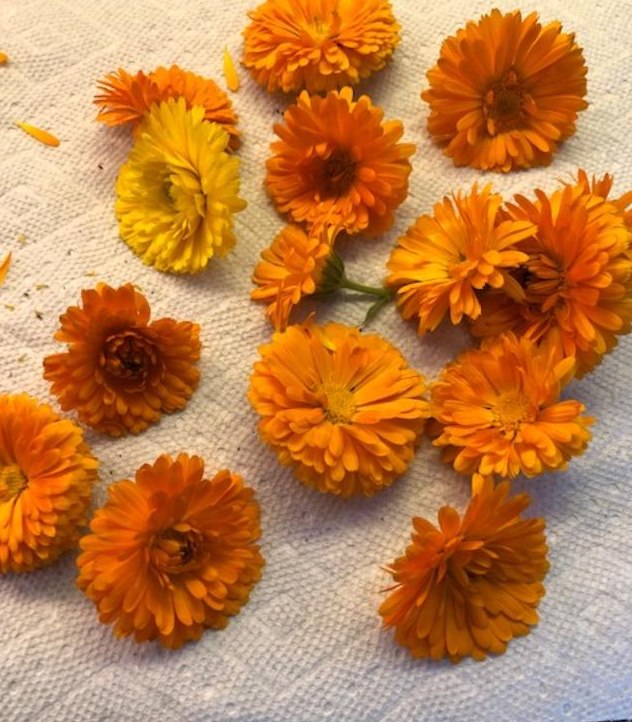 The Romans are believed to have named the calendula after the Latin word calendae (a word referring to the day of the new moon), because they observed that the flowers opened on the day of the new moon. Carl Linnaeus gave the plant its botanical name in the 1750s.
The Romans are believed to have named the calendula after the Latin word calendae (a word referring to the day of the new moon), because they observed that the flowers opened on the day of the new moon. Carl Linnaeus gave the plant its botanical name in the 1750s.
In early days, calendula was often associated with magical powers. If you wore calendula flowers while in court, you would be victorious in legal matters (Cohen, 2021). People would sprinkle the flowers around their door to keep evil away, and under their beds to ensure that good dreams would come true.
Shakespeare’s writings contain at least six passages about marigolds (Macht, 1955). In several passages, he notes the use of marigold in honoring the dead. The passage in The Winter’s Tale, Act IV, Scene 3, reflects the common belief that marigold was also a heliotropic plant.
Here’s flowers for you;
Hot lavender, mint, savory, marjoram:
The marigold that goes to bed with the sun,
And with him rises weeping.
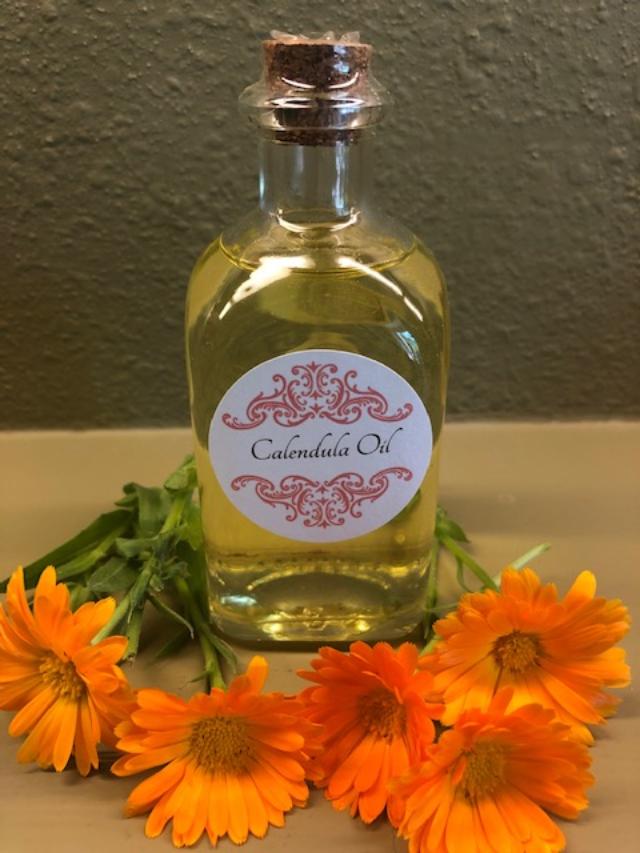 Sometime in history, it was discovered that calendula could be used as a medicinal plant. Since early times it was used as an effective treatment for skin irritations. During the U.S. Civil War, the flowers were used to stop bleeding and to promote healing of battle wounds. British garden designer Gertrude Jekyll led a campaign during World War I to raise calendula to supply British hospitals in France (Keeler, 2016).
Sometime in history, it was discovered that calendula could be used as a medicinal plant. Since early times it was used as an effective treatment for skin irritations. During the U.S. Civil War, the flowers were used to stop bleeding and to promote healing of battle wounds. British garden designer Gertrude Jekyll led a campaign during World War I to raise calendula to supply British hospitals in France (Keeler, 2016).
In traditional medicines, calendula was used to treat a variety of skin irritations. It was also used to treat earaches, eye and mouth irritations, jaundice, and menstrual problems. Clinical use today shows that it is effective in treating radiation burns (Patil, 2022). Some recent studies conclude that Calendula officinalis shows promise as an effective medicine, even as a treatment for some cancers (Patil, 2022), but that more clinical research needs to be done. Its antifungal, anti-inflammatory, and astringent properties make a healing treatment for the skin when infused in oil.
Calendula is also known as “poor man’s saffron.” The petals can be dried and used in place of the more expensive saffron. However, the taste is not the same as that expensive herb. The colorful petals and young leaves can be tossed into salads. The petals can be cooked with rice and mixed into egg salads, cakes, puddings, and soups.
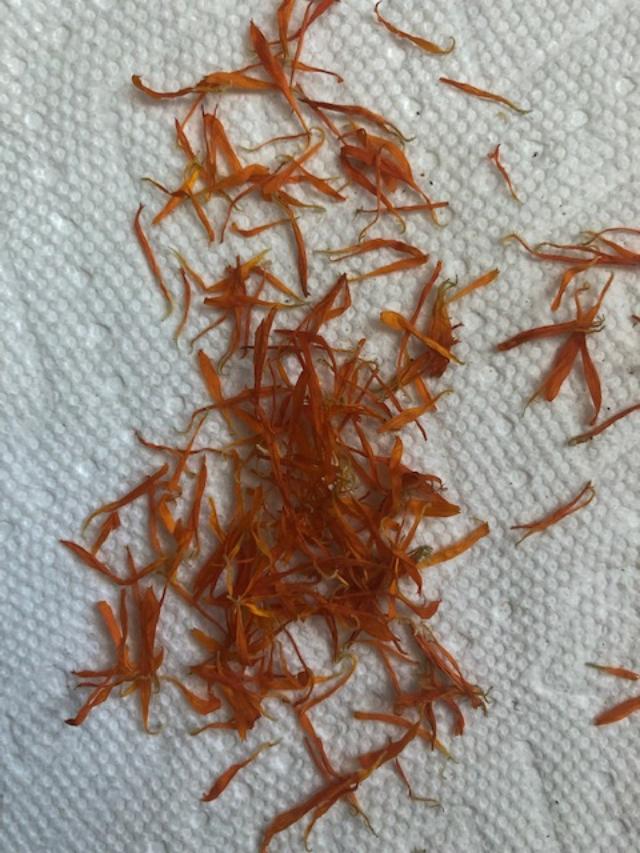 The petals have been used as a dye for fabrics and as an ingredient in cosmetics. Dried petals give a nice contrast color in potpourri. Some say that if the flowers are fed to hens, the resulting egg yolks will have a rich, yellow color (Barrett, 2009).
The petals have been used as a dye for fabrics and as an ingredient in cosmetics. Dried petals give a nice contrast color in potpourri. Some say that if the flowers are fed to hens, the resulting egg yolks will have a rich, yellow color (Barrett, 2009).
This very useful, colorful, and easy-to- grow herb deserves a place in every garden. For more information, recipes, and a beautiful screen saver, go to The Herb Society of America’s Herb of the Month webpage: https://www.herbsociety.org/hsa-learn/herb-information/herb-of-the-month.html
Medicinal Disclaimer: It is the policy of The Herb Society of America, Inc. not to advise or recommend herbs for medicinal or health use. This information is intended for educational purposes only and should not be considered as a recommendation or an endorsement of any particular medical or health treatment. Please consult a health care provider before pursuing any herbal treatments.
Photo Credits: All photos courtesy of the author.
References
Barrett, Judy. 2009. What can I do with my herbs? College Station, TX: Texas A & M Press.
Cohen, Bevin. 2021. The artisan herbalist. Canada: New Society Publishers.
Fischer, Fern. 2017. History of calendula. Accessed 4/3/22. Available from https://www.gardenguides.com/78027-history-calendula.html
Herb Society of America. 2008. Calendula: An Herb Society of America guide. Accessed 4/3/22. Available from https://www.herbsociety.org/file_download/inline/210f18de-fb79-4fe8-b79c-8b30bdca4885
Keeler, Kathy. 2016. Plant story: Marigolds in history – pot marigolds (Calendulas). Accessed 4/3/2022. Available from http://khkeeler.blogspot.com/2016/10/plant-story-marigolds-in-history-pot.html
Larkin, Deidre. 2010. Calendar girl. Accessed 4/16/22. Available from https://blog.metmuseum.org/cloistersgardens/2010/11/05/calendar-girl/
Macht, David. 1955. Calendula or marigold in medical history and in Shakespeare. Bulletin of the History of Medicine. 29:6, 491–502. Available from http://www.jstor.org/stable/44446726.
Mehta, Devansh, Parkhi Rastogi, Ankit Kumar, and Amrendra Kumar Chaudhary. 2012. Review on Pharmacological Update: Calendula officinalis. Linn. Inventi Rapid: Planta Activa. Vol. 2012. Accessed 4/3/22. Available from https://www.researchgate.net/publication/229067785_Review_on_Pharmacological_Update_Calendula_officinalis_Linn
Patil, Karthikeya, et al. 2022. A review of calendula officinalis-magic in science. Journal of Clinical and Diagnostic Research. 16:2, 23-27. Accessed 4/4/22. Available from Explora from Ebsco.
Maryann is the Secretary of The Herb Society of America and a Texas Master Gardener. She is a member of The Society’s Texas Thyme Unit in Huntsville, TX. She lectures on herbs and does the herb training for several Master Gardener programs. She gardens among the pines in the Piney Woods of East Texas.


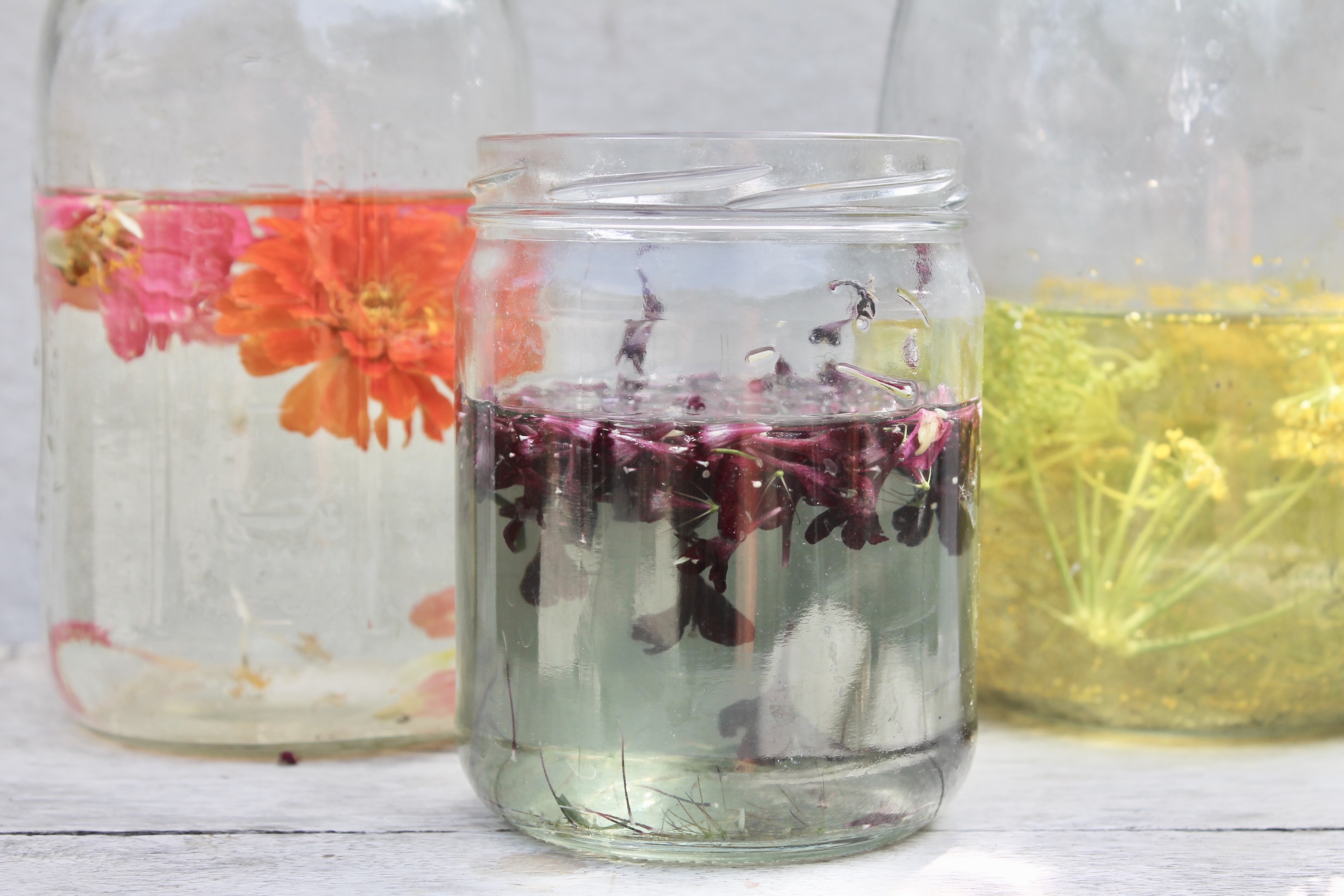 For those who love color AND plants, natural dyes connect you instantly to a vast range of artisanal hues that are truly vital, vibrant, and inherently meaningful through the ingredients themselves.
For those who love color AND plants, natural dyes connect you instantly to a vast range of artisanal hues that are truly vital, vibrant, and inherently meaningful through the ingredients themselves.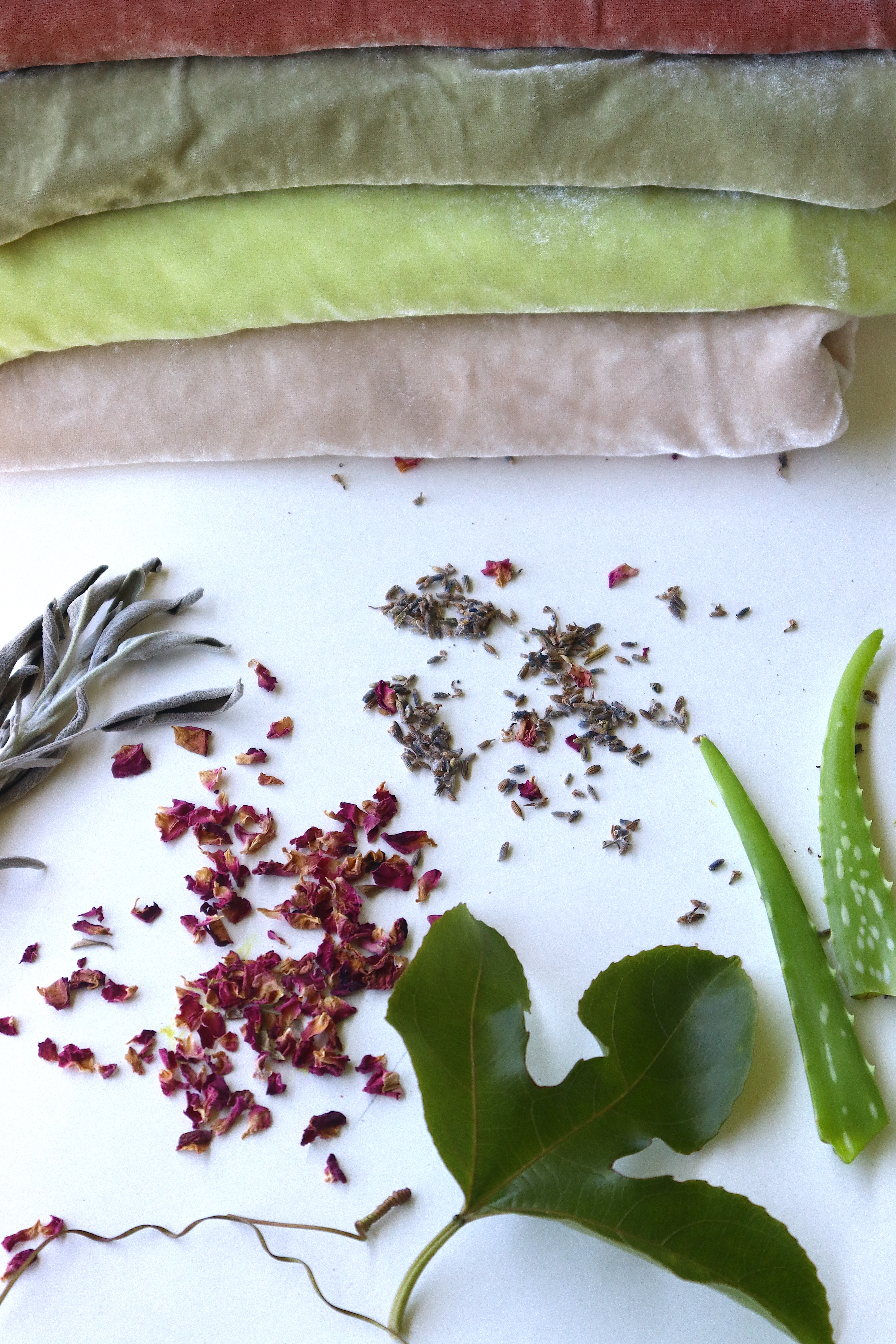 Lavender, mint, and passionflower leaves, which are sources of natural dyes, also have soothing therapeutic properties, easing sleep and anxiety by calming stressed nerves. These plants, as well as marigold, rosemary, sage, and aloe can also create a spectrum of aromatic hues from soothing yellows, to in-between blues, greens, and gray. True color therapy through and through.
Lavender, mint, and passionflower leaves, which are sources of natural dyes, also have soothing therapeutic properties, easing sleep and anxiety by calming stressed nerves. These plants, as well as marigold, rosemary, sage, and aloe can also create a spectrum of aromatic hues from soothing yellows, to in-between blues, greens, and gray. True color therapy through and through.  Working with natural color can be a way to forage for beautiful natural hues and to connect with your local ecologies, even in your own backyard or urban sidewalk. When working with a landscape, consider what is abundant, in season, accessible, and even invasive. Wild fennel – seasonally abundant on the West Coast or in summer gardens – can be quite an aggressive plant in the landscape (even on urban sidewalks!) making it a wonderful and seasonal dye to gather. Collecting fennel flowers and fronds at their peak or just after provides the brightest hues. Wild fennel can create gorgeous fluorescent yellows from both the fronds and blooms.
Working with natural color can be a way to forage for beautiful natural hues and to connect with your local ecologies, even in your own backyard or urban sidewalk. When working with a landscape, consider what is abundant, in season, accessible, and even invasive. Wild fennel – seasonally abundant on the West Coast or in summer gardens – can be quite an aggressive plant in the landscape (even on urban sidewalks!) making it a wonderful and seasonal dye to gather. Collecting fennel flowers and fronds at their peak or just after provides the brightest hues. Wild fennel can create gorgeous fluorescent yellows from both the fronds and blooms. 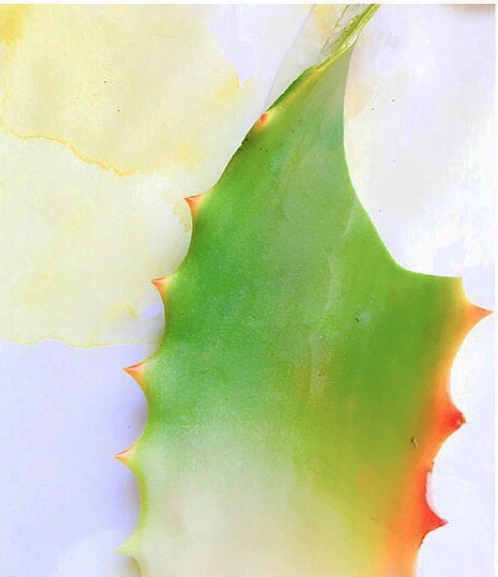 Aloe, a succulent whose soothing leaf gel helps to heal burns, keep the skin hydrated, and offer UV protection from the sun’s powerful rays, can also make calming color palettes. Aloe is used as a plant dye in many areas of South Africa, where the roots are most often used to dye wool red and brown. From the leaves you can also make luminous soft yellows and pinks—without the use of any additional mordant.
Aloe, a succulent whose soothing leaf gel helps to heal burns, keep the skin hydrated, and offer UV protection from the sun’s powerful rays, can also make calming color palettes. Aloe is used as a plant dye in many areas of South Africa, where the roots are most often used to dye wool red and brown. From the leaves you can also make luminous soft yellows and pinks—without the use of any additional mordant. 